Este post também está disponível em:
Português
English
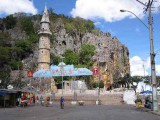
The Sanctuary of Bom Jesus da Lapa, a place of religious pilgrimage, is located within a complex of caves at the top of an elevation of approximately 100m, which stands out on the plain.
The Bom Jesus da Lapa Sanctuary is in the municipality of Bom Jesus da Lapa in the state of Bahia, 796 kilometres from Salvador.
The religious “high season” runs from July to September, when the city is visited by hundreds of thousands of people, reaching its peak on 6 August, dedicated to Bom Jesus da Lapa, whose image is carried in procession.
Video about the Sanctuary of Bom Jesus da Lapa
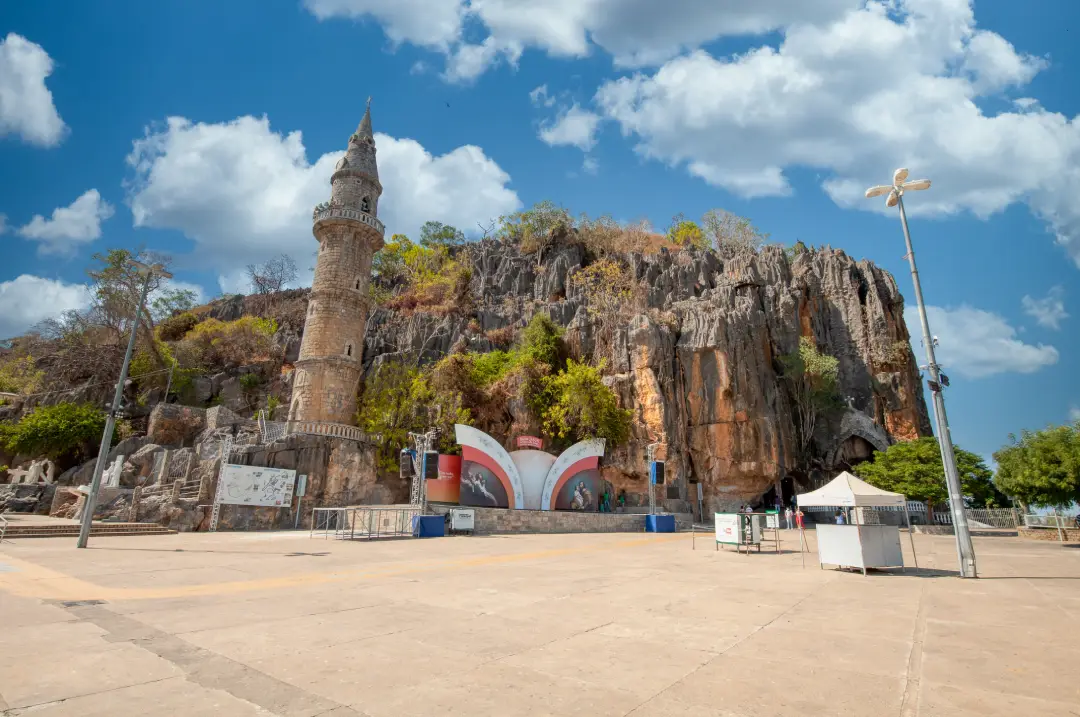

Santuário do Bom Jesus da Lapa - Guia de Turismo

Santuário do Bom Jesus da Lapa - Reportagem e História

Bom Jesus da Lapa - Capital Brasileira da Fé06:25
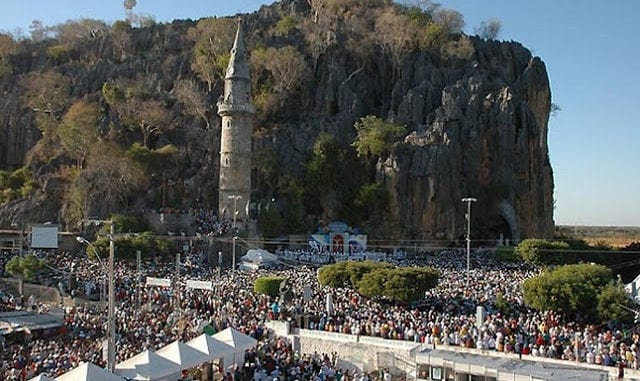
Bom Jesus da Lapa - Drone04:43
1. History of the Sanctuary of Bom Jesus da Lapa
1.1. Founder of the Sanctuary of Bom Jesus da Lapa
The Sanctuary of Bom Jesus da Lapa began to be a place of pilgrimage more than three hundred years ago.
In 1691, Francisco de Mendonça Mar discovered the cave, which until today serves as the Church of Bom Jesus da Lapa.
Francisco de Mendonça Mar was born in Portugal in 1657. He was the son of a goldsmith in Lisbon. He practised his father’s profession as a goldsmith and painter.
In his twenties, in 1679, he arrived in Bahia (Salvador), where he settled, having his own workshop and servants – his slaves.
In 1688, he was commissioned to paint the palace of the Governor-General of Brazil in Bahia. Instead of being paid, he was taken to jail with two of his slaves and cruelly flogged.
Touched by divine grace, recognising the vanity of the world, Francis learned that the only thing that counts is eternal salvation.
He decided to leave everything and seek the remotest desert to sacrifice his life for God. That was the reason he left the world – for the Glory of the Good Lord Jesus and for the good of others.
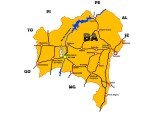
He sought neither fame nor worldly riches, but to imitate the Good Jesus in word and deed.
For it would be wrong to say that he “sought work and was forced to give up his rights as a worker…” He was not forced to do so by anyone, it was his free decision. He gave away his possessions, became poor and, accompanied by an image of Christ Crucified, set off into the hinterland.
He crossed the backlands of Bahia, dressed in a thick burel. He travelled some two hundred leagues among ferocious tribes of anthropophagous Indians, starved, suffered the heat of the sun, and was exposed to the dangers of jaguars, snakes, mosquitoes and other wild creatures that inhabited the virgin forests of the hinterland.
One afternoon, after several months of incessant walking, he came upon a hill, climbed a rough slope, and through an opening in the rock entered a cave. Inside he found a prodigious cavity, so proportionate to the Cross he was carrying, that he placed it there.
That was exactly what he was looking for! A perfect Mount Calvary. It was a sign from God that he should stay!
Here, on the banks of the River St Francis, he began a life of hermitage, in solitude and prayer, venerating the Good Lord Jesus who died on the Cross for our salvation and praising Mary, his Mother, the Virgin of Solitude.
This grotto, formerly the home of jaguars, became his dwelling place and was soon converted by Francis into a place of prayer, a Catholic temple! This was in the year 1691.
Dedicated to prayer and penance, “The Monk” Francis soon realised that love of God cannot be isolated from life, but inserted into it, so he began to work in favour of the most needy.
He brought the poor, the sick, the unfortunate and the crippled to himself in order to serve them with love, developing his apostolate also among the Indians of the neighbourhood.
At the same time that Francis discovered the Grotto of Bom Jesus, the first gold mines were discovered in the territory that would later be called Minas Gerais.
And the São Francisco River was at the time the best and only way to penetrate the interior of Brazil. Euclides da Cunha says in his book “Os Sertões”: “The direct and normal routes to the coast, shorter but interrupted by the walls of the mountains or locked by the forests, were closed off, and access was made by the São Francisco River.
It opened up two unique roads for explorers, to the source and the mouth, taking the men of the south to meet the men of the north. From the beginning, the great river was the link between the two societies that did not know each other…”
And so the movement began. Endless streams of adventurers, gold hunters, peddlers and cowboys, travelled up the River São Francisco, landing at this Lapa to pray, make promises and give thanks to God before the images of Bom Jesus and Nossa Senhora da Soledade, placed by the Monk on an altar in the main chapel of the Grotto.
By his example and his words, Francisco “The Monk of the Grotto” succeeded in sparking in the hearts of many people a love for the Good Jesus and His Holy Mother.
As an example of living faith and love, he built the first hospital for the sick and an asylum for the poor at the grotto’s gates, and was himself a nurse and protector of those suffering people.
Francis would show the image of the Good Jesus nailed to the cross to all those he healed, telling them that it was the Good Jesus who did that healing and still wishes to heal within us all the ills that harm our person and that of our neighbour.
1.2. Grotto and Chapel
The venerated image of Christ Crucified, under the title of Bom Jesus, was exposed inside the grotto attracting everyone who passed by.
The cult of the Lord Good Jesus, who died on the cross for our salvation, began to win the hearts of even the intrepid bandeirantes, gold hunters and land conquerors. Thus was discovered the Sanctuary of the Lord Good Jesus, called “da Lapa” because it was in the Grotto where his image was exposed.
Euclides da Cunha, quoted earlier, reveals that “… the owners of the soil, of which the heirs of Antônio Guedes de Brito are the classic models, were jealous of large estates, without lanes, overwhelming the land. They tolerated the intervention of the metropolis itself at great cost.
The erection of chapels or parishes on their lands was always done through controversy with the priests and, although the priests won the match, they somehow fell under the domination of the great ones.
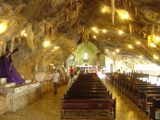
These made it difficult for new settlers or competitors to enter and made the breeding farms scattered around the newly formed frequesias powerful centres of attraction for the mestizo race that came from them: Thus, it developed outside the influence of other elements… acquiring an original physiognomy.
As if they were created in a different country…”
Francisco de Mendonça Mar, by his chosen way of life and the apostolate he developed, did not fall under the domination or dependence of the great, but rather created an autonomous entity, independent of the powerful of this world, receiving directly from the King of Portugal the donation of land for the Sanctuary.
This gesture gave him exemption from any interference and placed him at the level of grantee of the crown.
That is why the Shrine of Bom Jesus da Lapa has never belonged to any landowner in its history.
It was exempt, although its lands throughout history were gradually stolen and even the hill itself mutilated and invaded by force by local chieftains, who after 300 years are asking themselves: “What about the deed?”. Does the Sanctuary have the deed from the town hall?”
Francisco lived humbly from fishing and a small vegetable garden. He became known for his kindness. Everyone admired him.
He hid himself, but the Good Jesus revealed him, for the travellers, returning to Bahia, carried the news that in the heart of the sertão, in a beautiful cave on a hill on the banks of the River São Francisco, lived the MONGE OF THE GRUTA, a man who carried out a fruitful apostolate preaching the Gospel of the Good Jesus.
This news reached the ears of the Archbishop of Bahia, Dom Sebastião Monteiro da Vide.
In 1702, he sent a Visitor General who verified that all the news about the cult of the Lord Good Jesus and the exemplary life of the Monk were true. He therefore brought favourable information, both about the good spirit which animated the monk and about the place where the Holy Image of Christ Crucified was venerated by a large number of people.
The priests were already celebrating Mass there, as they had all the vestments necessary for the service.
The Visitor General, seeing that the cult of Bom Jesus was flourishing and that there was already a pilgrimage, although small, erected that temple that nature had made, in chapel, or church, with the title of LORD GOOD JESUS and OUR LADY OF SOLEDAD.
1.3. “The Monk – Becomes a Priest”
The Archbishop called “The Monk” to Bahia (Salvador) and, after a preparation, ordained him priest in 1706. He appointed him Chaplain of the “Sanctuary of the Lord Good Jesus of Lapa and of Our Lady of Solitude”. In honour of her, the Monk of the Grotto was renamed PADRE FRANCISCO DA SOLEDADE.
Father Francisco returned to the Grotto, organised the cult, led by apostolic zeal, preached throughout the part the Holy Gospel, administering the sacraments, advising and healing the sick, consoling the slaves; making the Good Jesus and the Lady of Soledade, better known and loved.
In response to the love of the Good Lord Jesus, these people felt the obligation to go on pilgrimage to the grotto, visiting his image there, especially on the feast days (06 August and 15 September each year), in order to thank the graces received.
Thus was born the ROMARIA, which to this day remains an expression of faith and love for Bom Jesus.
Father Francisco da Soledade, “the Monk of the Grotto”, was the initiator of the cult of Bom Jesus and the organiser of the Shrine.
It was he who made the first altars, obtained parâmentos, candlesticks, the image of St Anthony of Lisbon and that of Our Lady of Soledade.
The grotto became the Sanctuary of Senhor Bom Jesus: it became a wonderful church, a place of rest and devotion for travellers, a pilgrimage and pilgrimage centre, with an infirmary, a hospital for the sick and an asylum for poor people, all of whom were treated with great charity.
It was also a centre of agriculture, since the “Monk” planted the crops of the hinterland, and it also became a centre of missions, from where these radiated to the most distant places of the immense hinterland.
It is almost certain that Father Francisco died in Lapa. Poor, humble and pious as he had lived, he surrendered his spirit to the Creator in the same shrine which he had founded. His death probably occurred after 1722, at the age of about 65.
Tradition points to the “Monk’s grave”, on the right side of the main altar, as the place where his body was buried. It is the same grave where he prayed and did penance and which served as his dormitory.
There you can see a black marble stone with the inscription: “HERE WAS SEPULTED FATHER FRANCISCO DA SOLEDADE, SECULAR SACERDOT, WHO BRINGED THE MIRACULOUS IMAGE OF THE GOOD JESUS TO THIS LAPA AND LIVED IN IT IN PRAYER AND PENANCE. REST.”
2. Tourism in the Sanctuary of Bom Jesus da Lapa
2.1. City of Bom Jesus da Lapa
Bom Jesus da Lapa is a municipality located in the western region of the state of Bahia, 850 km from the capital. Its population in 2007 is 62,199 inhabitants according to IBGE.
It has a total area of 4148.5 km² and is bathed by the São Francisco River. Its economic activities are based on agriculture, livestock, trade, tourism and fishing.
The city of Bom Jesus da Lapa concentrates the third largest pilgrimage in Brazil, in the month of August, known as the “Romaria do Bom Jesus”, which attracts thousands of faithful every year.
The great differential between Bom Jesus da Lapa and the other cities of the region is the hill and its caves that give it a mystical and differentiated climate and the permanent state of pilgrimages.
The town of Bom Jesus da Lapa began its existence in the shadow of the Sanctuary of Bom Jesus. When the Monk arrived there were only a few huts of Tapuias Indians between the hill and the river São Francisco.
But over time, devotees began to gather and decided to make their homes near the place where the image of Bom Jesus was located. The monk built an asylum next to the sanctuary for the poor and sick, whom he cared for.
Thus a village began to grow next to the lapa of Bom Jesus, assuming the same name of Bom Jesus da Lapa.
Thanks to the constant pilgrimages that became large and permanent pilgrimages of the faithful to the Sanctuary of the Lord Bom Jesus, the village developed, becoming a town in 1870, reaching the category of city in 1923, when it was emancipated on 31 August of that year.
2.2. The hill of Bom Jesus
Bordering the river São Francisco, in the backlands of Bahia, is the sanctuary of Bom Jesus da Lapa.
It is an imposing limestone massif, ninety metres high, cut into galleries and caves. Black in colour, the cliff carries within it the common vegetation of the drought-stricken region.
The hill looks like a patch of limestone mountain, isolated in the middle of a plain, with the base almost in the water and the edge crowned with cacti, thorn bromeliads and minarets of various shapes.
There are several caves here: Bom Jesus, 50 metres long, 15 metres wide and 7 metres high; Soledade, the largest in size; and, for the admiration of pilgrims and visitors, other beautiful but smaller caves.
2.3. Sanctuary of Bom Jesus da Lapa
The shelter was discovered in 1691 by the Portuguese Francisco Mendonça Mar, who, like his father, was a goldsmith and painter. In his twenties, in 1679, he arrived in Salvador da Bahia, where he set up his own workshop.
In 1688, he was commissioned to paint the palace of the Governor General of Brazil in Salvador, but instead of receiving payment, Francisco was taken to jail and cruelly flogged.
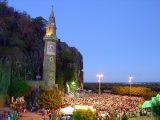
Touched by divine grace, recognising the vanity of the world, he learned that the only thing that counts is salvation.
Distributing his possessions, he became poor and, accompanied by an image of the crucified Christ, he set out into the hinterland. He walked among tribes of anthropophagous Indians, starved, and suffered the heat of the sun.
One afternoon, after several months of incessant walking, he came upon a hill, climbed a rough slope and, through an opening in the rock, entered a cave.
Inside, he found an ideal cavity in which to place the cross he was carrying. There, on the banks of the River St Francis, he began a life of hermitage.
Dedicated to prayer and penance, the monk soon realised that love of God cannot be isolated from life; so he began to work in favour of the needy, bringing the poor, the sick, the unfortunate and the crippled to himself in order to serve them with love.
In 1702, at the request of the Archbishop of Bahia, Dom Sebastião Monteiro de Vide, he went to Salvador to prepare for the priesthood.
He studied for three years and was ordained a priest in 1705. After his ordination he took the name of Father Francisco da Soledade and returned to Lapa where he lived until his death in 1722.
2.4. The pilgrims
The cave where the monk Francisco placed the cross became the sanctuary of Bom Jesus da Lapa.
It is more than a cavity in the rock: it is a sanctuary built by the hand of nature and chosen by God. In front of the image of the Crucified, pilgrims of all ages from different parts of Brazil kneel.
They bring with them a penitent heart, a fervent prayer of simple words that spring up spontaneously.
At the altar of Bom Jesus, we can hear them babbling prayers; others, loudly, make their requests and thanks; others mix words with tears and others pay promises, leaving ex-votos, such as photos, letters, crutches etc.
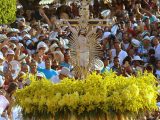
It is to Him that the pilgrim commends his life and that of his family and friends, surrendering himself to His protection.
The promise made and fulfilled is a way of thanking God for all the good that he, “poor man”, receives from divine hands.
The pilgrim is characterised by his straw hat rustically covered with white fabric and coloured ribbons. The most common is white, symbolising hope.
A picturesque fact in the city is that almost all public telephones (orelhão) are in the shape of a hat.
2.5. The time of the pilgrimage
Since time immemorial, the feast of Bom Jesus has been celebrated on 6 August, but in fact the pilgrims’ movement begins right after the feast of Saint John.
In the sanctuary and in the city, the movement intensifies from 28 July, when the novena begins on the esplanade, culminating on 6 August with the solemn celebration.
In the mornings and afternoons, there is a procession through the main streets of the city, where the float carrying the miraculous image of Bom Jesus da Lapa stands out.
In 2000, the sanctuary was visited by more than 1,200,000 pilgrims, and in 2001, the Military Police estimates that the city received almost 300,000 people on the day of the festival.
The time of the pilgrimage does not end with the feast, but continues until the end of the year. Miners, paulistas, cariocas, capixabas, goianos, baianos and others. They all meet at the feet of Bom Jesus.
The founder of the sanctuary, Fr Francisco da Soledade, was very devoted to Our Lady. When he went on pilgrimage in search of the ideal place to do penance, he also brought a small image of Our Lady of Sorrows.
From the beginning, on 15 September, the beautiful feast is celebrated with the participation of thousands of pilgrims.
2.6. The ongoing mission of the Redemptorists
Fr Francis’ mission has continued successfully on this earth for more than three centuries (1691-20090). Each year the shrine receives an ever-increasing number of visitors and the fame of the place has spread not only in Brazil but also in the world.
The Missionaries of the Most Holy Redeemer (Redemptorists) have been working in Lapa since 1956.
For the first 20 years, the confreres of the Vice-Province of Recife worked there, and from 1973 the Vice-Province of Bahia took over responsibility for the shrine.
The work with pilgrims throughout the year is a permanent mission.
In this northeastern reality, the poor pilgrim comes to the shrine, often abandoned materially and spiritually; for this reason he needs to be welcomed and to take with him the Gospel message and spiritual strength.
The pastoral work of the shrine has a great influence on the religious life of the region.
The pilgrim always has the opportunity to take part in various collective events, such as the Pilgrimage of the Earth and the Waters, the Pilgrimage of the Pastoral of the Child, the Pilgrimage of the Legionaries, the Pilgrimage of the Health and Endemic Agents, etc.
The natural beauty and the strong devotion to Bom Jesus make this place “the Bahian capital of faith”. For the people of the Northeast, it is a truly sacred place.
2.7. Invitation
Come too, contemplate this beauty and visualise the most beautiful sunset in the San Franciscan hinterland.
If, by any chance, you are thinking about the distance! Say like a good Bahian: “it’s right there”.
Get your group together and come and unravel the mysteries of the limestones of the hill of the Sanctuary, which fascinated Francisco da Soledade in times gone by, and which today fascinate thousands and thousands of pilgrims.
History and religious tourism in the Sanctuary of Bom Jesus da Lapa
Bahia.ws is the largest tourism and travel guide for Bahia and Salvador.



















